#Krishnanand Jha
Text
The Tantric Gods of Krishnanand Jha
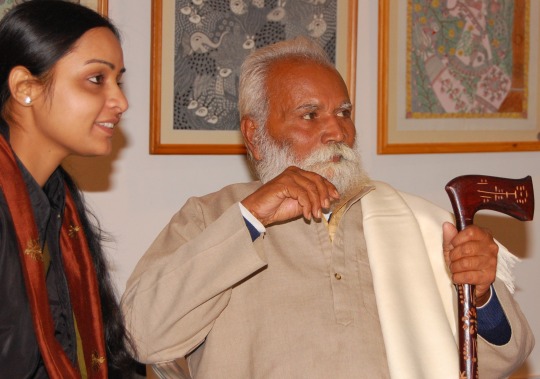
Krishnanand Jha (right) with the Mithila painter Amrita Jha at Arpana Caur Academy of Fine Arts and Literature in New Delhi, Feb1, 2013.
Krishnanand Jha's art is like that of no other Mithila painter. Perhaps that's not surprising for someone who didn't set out to be a painter. When he couldn't find a job after graduating college, he decided his diploma was worthless, tossed it into the Ganges and turned to painting.
Krishnanad Jha's grandfather was a Tantric priest and his father practiced Tantra. Although he himself is somewhat ambiguous about his Tantra practices, much of his work consists of paintings of individual Tantric gods, and his family goddess Chinnmasta, a powerful shakti (feminine power) goddess, is worshipped according to Tantra rituals.
Here is an excellent example of his work from the 1980's : the eighteen armed Anand Bhairav , 22"x30", a fierce aspect of Shiva as Lord of Destruction.

An absolutely stunning composition that exhibits Krishnanad Jha's unique style at its best: the imposing figure of Bhairav is barely contained by the picture space. Our attention immediately centers on the white angular faces, in profile, with their large Mithila eyes, and then the arms, branching out from the body, nine on each side, white like the faces, the whole forming a circle against the pastel green of the background. The effect created by these faces and wide open arms is captivating and dominates the rest of the painting decorated with repetetive designs and pastel coloring.
Krishnanand Jha's representation of gods and humans in these early 1980's paintings is very particular: his figures are elongated, large, with much too small, almost stunted legs and feet, as in this painting where a child-like leg appears at the bottom of Bhairava's robe. Note also Bhairava's profile, forehead through nose drawn as half a triangle, a characteristic of Krishnanand Jha representation of the face.
Next, The Tantric Guru "22x30". A guru, not a god, but painted in the same style. Krishnanand Jha said that while working on this painting he had in mind the Tantric gurus who guided him when he was younger.
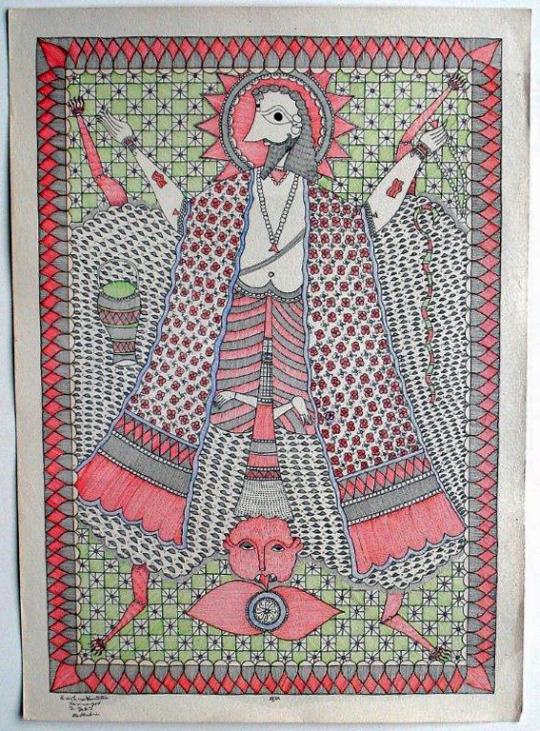
With upraised arms marked with the sign of Shiva, a Tantric guru of Kundalini yoga sits in lotus posture on a tiger skin, his begging bowl beside him. His upper torso with sacred thread and prayer beads is white, as are his face and arms while his robe decorated with small red flowers sets itself off from the dark repetitive markings of the tiger skin. The tiger's head and protruding tongue are at the bottom of the painting while the tiger's feet and claws, characteristically dwarfed as are the legs of the guru, extend into the four corners.
The Tantric Goddess Dakini whose assistance is sought in Kundalini yoga. 22"x30".
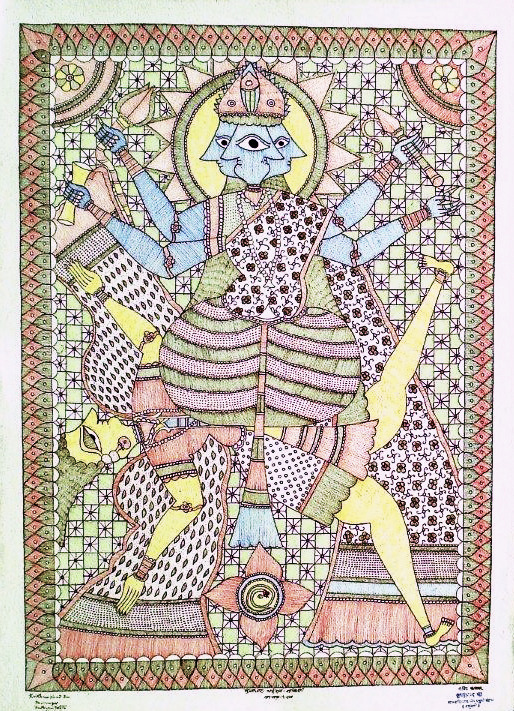
The goddess Dakini is always portrayed with three heads and four hands according to Krishnanand Jha. With a lotus, a manuscript, and a weapon in three of her hands while the fourth is empty, the goddess stands on the prone figure of the great Lord Shiva. We are in the world of shakti, female power, where it is the feminine not the masculine that is worshipped. At the bottom of the painting, the coiled snake in the lotus tells us we are dealing with a Tantric goddess of Kundalini yoga. The snake represents dormant psychic, spiritual energy, that can be awakend through meditation and other practices with the help of the goddess. Once awakened, the energy uncoils and travels upward from the base of the spine through various spiritual and meditative stages untill it reaches the crown of the head to produce a mystical relevatory experience of self-realization, sometimes thought of as the union of the goddess with Shiva.
In this painting Krishnanand Jha abandons his practice of leaving the figure white to stand out against the color and decoration of the rest of the painting. Both goddess and god are important here so both are equally painted in color though Dakini with her blue color and position at the top of the painting is given prominence as befits the narrative.
The goddess Durga without her lion mount. 22"x30".
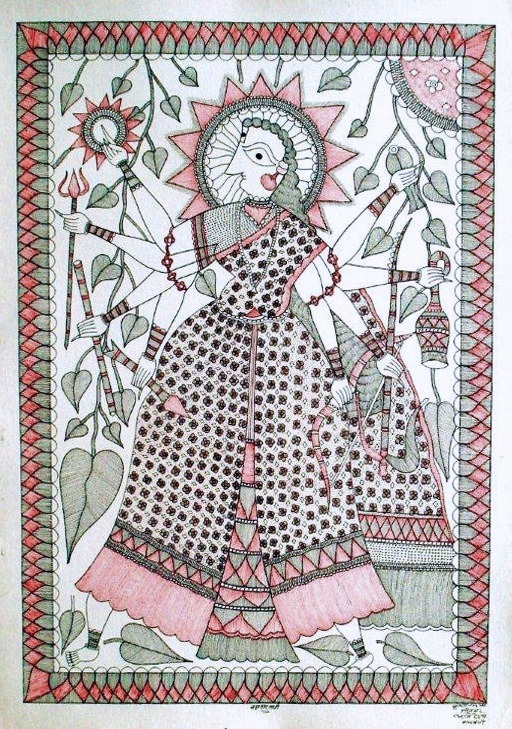
This painting is quite different from the previous single figure paintings. The goddess Durga with colored dress, wrist bands and starred halo is here set against a white background. Two vines with black and white leaves, their thin parallel lines drawn with a very fine nib, descend from the top, one on each side. The piece is striking with the eight armed goddess, weapon in each hand, filling the entire frame, yet it is also oddly peaceful perhaps because of the white background and simple decoration.
The very fine lines of the leaves bring to mind a conversation with the artist Rambharos about his studies with Krihsnanand Jha. He mentioned that the older artist was never satisfied with the line made by the nib pens he bought commercially but would always whittle the nibs down to achieve varied thicknesses of line.
Another example of Krishnanand Jha's 'white background' style - this time in a three figure Ramayana painting, Rama, Sita and Lakshmana 22"x30".
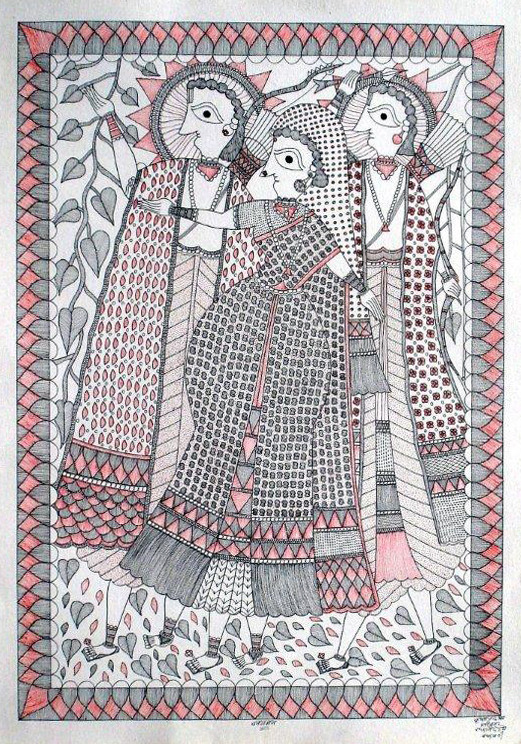
The force of this painting comes from the simple, pared down figures, and repetition, either of decorative elements or of the figure itself. The faces are the same except for Sita's nose ring. And though both Rama and Lakshmana have halos and Sita doesn't, her sari with its large curve over the top of her head serves the same visual purpose. Allowing a slight difference for Sita's feminine dress, their clothing is also similar. The repetitive figures draw our attention to the decoration - particularly the play of the various designs and colors on the wide border at the bottom of their dress. There is enough difference for the eye to take enjoyment but not so much that we have to strain to make sense of what we are seeing.
The repetition also makes certain variations significant, even dramatic, as in the gesture by Sita, her arm thrown forward as if indicating the direction these travellers should take.
The Trimurti - Brahma, Vishnu and Shiva - responsible for the creation, maintenance and destruction of the world. 22"x30"
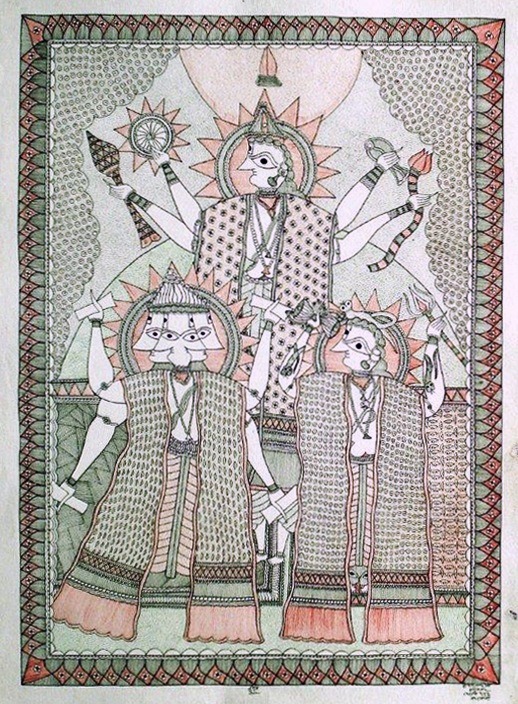
A very effective composition. The three gods present an imposing scene as rulers of the universe. The repetion of the simple geometric form despite differences in decoration, despite Brhahma's four faces, creates a powerfull impression on the viewer. As if onstage, curtain drawn back, these almost totem-like figures exhibit their power as they reveal themselves to their worshipers.
I would like to finish with a painting that holds special meaning for Krishnanand Jha: Chinnamasta and Baglamuki, 22"x30".
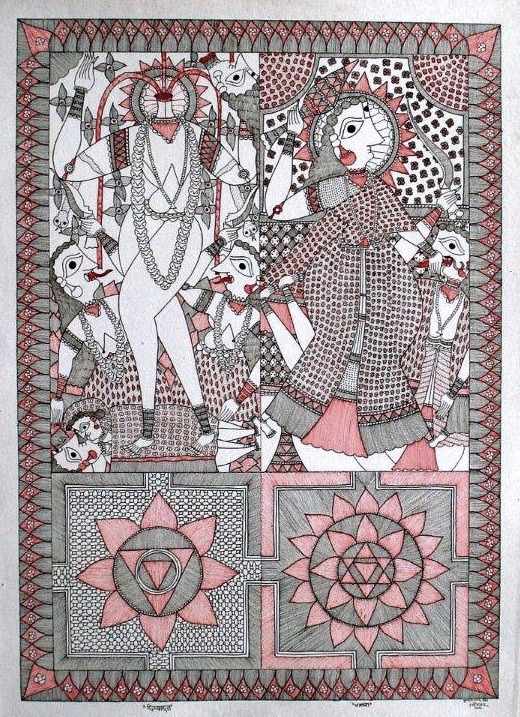
These are two of the ten Mahavidya (great wisdom) goddesses who are manifestations of the Great Goddess envisioned and worshiped as the Supreme Being of all existence.
Chinnamasta is shown holding her severed head in one hand while standing on a copulating couple. Three streams of blood spout from her neck, one into her own mouth and the other two into the mouths of her two followers. In simplest terms, Krishnanand Jha says she represents the destructive and generative principle of the world. The other goddess, Baglamuki, is the goddess who releases individuals from their spiritual misconceptions and also defeats their enemies. She is shown pulling the tongue of a demon with one hand while preparing to crush him with the club she holds in the other. The yantra diagram painted below each goddess is necessary for the proper execution of their worship ritual.
Chinnamasta is special for Krishnanand Jha. She has been his family's goddess for hundreds of years and he continues the tradition. There is a special room in the house for her and she is consulted before any important decision. On those occasions Tantric prayers are said, a he-goat is sacrificed, and the entire family eats this sacred meal. He says he often paints the Mahavidyas because these paintings bring him peace and help him deal with spiritual and mundane problems in his own life.
Krishnanand Jha has suffered from Parkinson's disease for over a decade and now no longer paints. At the Ethnic Arts Foundation's exhibition of Mithila Art: the New Generation in New Delhi this February, 2013 he was honored for his life's work and there is a celebratory volume of his paintings in preparation.
4 notes
·
View notes